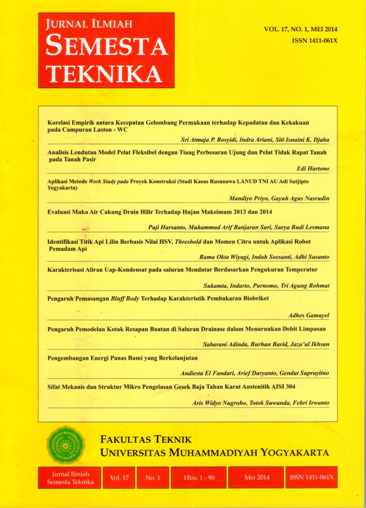Aplikasi Metode Work Study pada Proyek Konstruksi (Studi Kasus Rusunawa LANUD TNI AU Adi Sutjipto Yogyakarta)
DOI:
https://doi.org/10.18196/st.v17i1.405Abstract
Work study method is one of the management approach that use for study about the productivity of workers. Work study can be applied in many cases, one of which is the construction of Rusunawa TNI AU Lanud Adi Sutjipto Yogyakarta. Chosen plant project Rusunawa TNI AU Lanud Adi Sutjipto Yogyakarta because this project uses a system of precast concrete in construction. Precast concrete systems is still quite rarely used in Yogyakarta so that this is makes the researchers reviewed the project to study the case. This study aimed to compare the time between installation plan (time schedule) and the actual installation time also to know the time clean installation of structural elements. In addition, this study also aims to determine the cost of erection of a single structural element. This study utilizes the basic time data by consider relaxation allowance and contingences for the purpose to eliminate subjectivity in assessing both. Basic recording time is using a stopwatch. Whereas the standard time value can be from basic time coupled with relaxation allowance and contingences. The results of this study have shown that the value of the standard time for the installation of columns, beams and plates is 13.63163 minutes; 8.505156 minutes; 8.465704 minutes. Obtained also the cost of erection of columns, beams and slabs of Rp 24629.96; Rp 15710.91; Rp 15710.91.
Downloads
Published
How to Cite
Issue
Section
License
Semesta Teknika is licensed under a Creative Commons Attribution 4.0 International License.
Authors who publish with this journal agree to the following terms:
- Authors retain copyright and grant the journal right of first publication with the work simultaneously licensed under a Creative Commons Attribution License that allows others to share the work with an acknowledgement of the work's authorship and initial publication in this journal.
- Authors are able to enter into separate, additional contractual arrangements for the non-exclusive distribution of the journal's published version of the work (e.g., post it to an institutional repository or publish it in a book), with an acknowledgement of its initial publication in this journal.
- Authors are permitted and encouraged to post their work online (e.g., in institutional repositories or on their website) prior to and during the submission process, as it can lead to productive exchanges, as well as earlier and greater citation of published work (See The Effect of Open Access).









